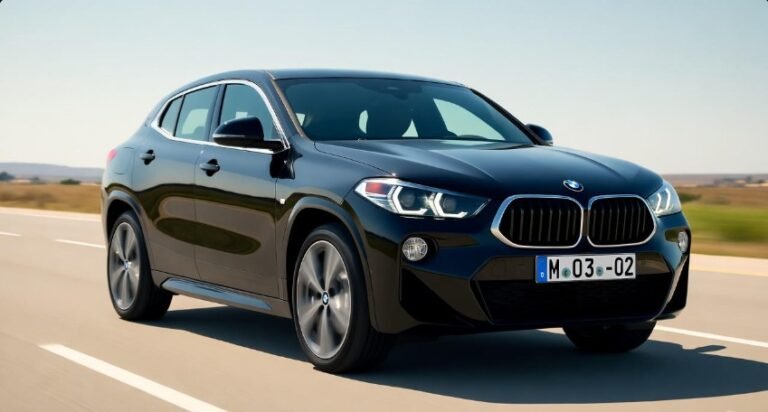BMW Bike Accident Bangalore Today: 7 Facts

BMW Bike Accident Bangalore Today: 7 Shocking Facts You Need to Know
Key Takeaways
Understand the critical facts surrounding BMW bike accidents in Bangalore.
Learn about common causes and preventive measures for motorcycle safety.
Discover recent accident trends and their implications for riders.
Access resources for accident reporting and rider education in Bangalore.
Prioritize safety and awareness to reduce risks on the road.
When it comes to motorcycle safety, being informed is your first line of defense. Today, we’re diving into a topic that might cause concern: BMW bike accidents in Bangalore. Accidents involving any vehicle, especially powerful motorcycles like BMW bikes, happen for various reasons. Understanding the specifics of these incidents can help you, as a rider or a fellow road user, stay safer. This guide will break down seven key facts about BMW bike accidents in Bangalore today, making complex information easy to grasp. Let’s explore what you need to know to navigate the roads more securely.
The Rise of High-Performance Bikes and Accident Statistics
High-performance motorcycles, including those from brands like BMW, offer an exhilarating riding experience. However, their power and speed also necessitate a higher degree of skill and caution. When discussing BMW bike accidents in Bangalore today, it’s important to consider the broader context of motorcycle accidents in the city. While specific, real-time data on every single BMW bike accident can be fluid, understanding general trends is crucial. Bangalore’s dynamic traffic environment, with its mix of vehicles, road conditions, and driver behaviors, contributes to the overall complexity of road safety. Reports often highlight that a significant percentage of road fatalities and severe injuries involve two-wheelers. This underscores the vulnerability of motorcyclists and the importance of focusing on their safety. Research from organizations like the World Health Organization (WHO) consistently points to the disproportionate risk faced by motorcyclists compared to occupants of cars.
Fact 1: Speeding as a Major Contributor to BMW Bike Accidents
One of the most consistently identified factors in severe motorcycle accidents, including those involving powerful machines like BMW bikes, is excessive speed. The sheer power of a BMW motorcycle means that higher speeds can be reached very quickly. When a rider exceeds speed limits or rides at speeds inappropriate for road conditions (such as sharp turns, wet surfaces, or heavy traffic), the margin for error shrinks dramatically. A study by the National Highway Traffic Safety Administration (NHTSA) in the US, which often influences global safety standards, highlights that speed is a factor in a substantial portion of fatal motorcycle crashes. In Bangalore, where traffic can be unpredictable, out-of-control speed is a recipe for disaster. It reduces a rider’s ability to react to sudden obstacles, brake effectively, or maneuver out of danger.
Fact 2: Rider Skill and Experience: A Critical Factor
Riding a high-performance motorcycle like a BMW demands a significant level of skill and experience. These bikes are designed for performance, and their responsiveness can be a shock to riders who are not adequately trained or experienced. Inexperience can manifest in several ways:
Lack of Proper Braking Techniques: Misjudging braking distances or using brakes incorrectly can lead to loss of control.
Inability to Handle Cornering: High speeds in curves, without proper body positioning and throttle control, can result in skidding or veering off course.
Poor Hazard Perception: Newer riders may struggle to anticipate potential dangers on the road, such as potholes, sudden stops, or other vehicles.
Overconfidence: Sometimes, riders with moderate experience can become overconfident, leading them to take unnecessary risks.
Organizations like the Motorcycle Safety Foundation (MSF) in the USA offer extensive training programs that emphasize the importance of continuous learning and skill development for riders of all experience levels.
Fact 3: The Role of Road Conditions and Infrastructure
Bangalore’s roads, like those in many rapidly developing cities, can present unique challenges. Potholes, uneven surfaces, gravel, oil slicks, and poorly maintained infrastructure are significant hazards for any vehicle, but they are particularly dangerous for motorcycles. A BMW bike, with its suspension and tire design optimized for performance on good roads, can be significantly affected by poor road conditions. A sudden encounter with a large pothole can cause a rider to lose balance, leading to a fall. Similarly, debris on the road can cause a tire to skid. Local authorities are often working to improve road infrastructure, but ongoing maintenance and awareness of these hazards are crucial for riders.
Fact 4: Interaction with Other Vehicles: A Common Cause
A significant number of motorcycle accidents, including those involving BMW bikes, occur due to collisions with other vehicles. These can happen in various scenarios:
Cuts by Cars: When a car turns in front of a motorcycle, or changes lanes without seeing the bike, it can lead to a direct collision. The smaller profile of a motorcycle makes it harder for car drivers to spot.
Rear-End Collisions: While less common for motorcycles, sudden braking by the bike can lead to a car hitting it from behind, especially if the car driver is following too closely.
Merging and Lane Splitting: Although lane splitting is not officially endorsed or legally defined in many parts of India, the reality of dense traffic often leads to riders navigating between lanes. This increases the risk of being hit by vehicles attempting to change lanes or turn.
To mitigate this, riders are often advised to maintain a visible position in their lane and to be aware of their surroundings, actively scanning for potential hazards. Defensive riding techniques, often taught in advanced rider courses, are invaluable here.
Fact 5: Impact of Weather on BMW Bike Riding
Weather conditions significantly impact motorcycle safety. Rain is a major concern, as it reduces tire grip, obscures vision, and makes road surfaces slippery. Braking distances increase substantially, and the risk of hydroplaning rises. Other challenging weather conditions include fog, which severely limits visibility, and strong winds, which can affect a motorcycle’s stability, especially at higher speeds. Even direct sunlight can cause glare, making it difficult to see road hazards or other vehicles. When riding a powerful machine like a BMW bike, adapting speed and riding style to suit the weather is paramount. It’s often advisable to avoid riding altogether during severe weather.
Fact 6: Importance of Protective Gear: The Unsung Hero
While not directly a cause of an accident, the absence or improper use of protective gear is a critical factor in the severity of injuries sustained during a BMW bike accident. A full-face helmet, riding jacket, gloves, sturdy pants, and proper footwear are essential for protecting riders from abrasions, impact, and other injuries.
Here’s a look at the essential protective gear:
- Helmet: A certified full-face helmet is critical for protecting the head, the most vulnerable part of the body. (Sources like the NHTSA emphasize helmet effectiveness.)
- Jacket: Abrasion-resistant riding jackets with armor protect the torso, shoulders, and elbows.
- Pants: Riding pants made of leather or durable textiles, with knee and hip protection.
- Gloves: Riding gloves protect hands from abrasions and impacts.
- Footwear: Sturdy, over-the-ankle boots protect the feet and ankles.
Riding a BMW bike without this gear dramatically increases the risk of life-altering injuries should an accident occur.
Fact 7: The Role of Technology and Rider Aids
Modern BMW motorcycles are equipped with advanced technology and rider aids designed to enhance safety. These can include:
Anti-lock Braking Systems (ABS): ABS prevents wheels from locking up during hard braking, allowing the rider to maintain steering control.
Traction Control: This system helps prevent the rear wheel from spinning under acceleration, especially on slippery surfaces.
Riding Modes: These allow riders to tailor the bike’s performance (throttle response, ABS, traction control settings) to different conditions and skill levels.
Stability Control: More advanced systems can help manage the bike’s behavior in challenging situations.
However, it’s crucial to remember that these are aids, not guarantees. They can significantly mitigate risks, but they do not replace rider skill, awareness, and adherence to traffic laws. Understanding how these systems work and when to use them effectively is part of responsible ownership of a high-performance motorcycle.
Common Causes of BMW Bike Accidents in Bangalore: A Table
Understanding the contributing factors can help riders make informed decisions. The table below outlines common causes, with a focus on scenarios relevant to powerful motorcycles like BMWs.
| Cause | Description | Impact on BMW Bikes | Mitigation Strategies |
|---|---|---|---|
| Excessive Speed | Riding beyond speed limits or road capacity. | Reduced reaction time, increased braking distance, higher impact force. | Adhere to speed limits, adjust speed for conditions, practice braking drills. |
| Inexperience/Skill Gap | Lack of adequate training or practice for high-performance bikes. | Difficulty controlling power, improper cornering, poor hazard perception. | Enroll in advanced riding courses, gain experience on less powerful bikes first. |
| Road Hazards | Potholes, debris, oil spills, loose gravel, uneven surfaces. | Loss of traction, sudden loss of balance leading to falls. | Maintain constant vigilance, scan the road ahead, practice evasive maneuvers. |
| Interaction with Other Vehicles | Cars turning without seeing bikes, lane changes, distracted drivers. | Vulnerability due to smaller size; potential for severe impacts. | Maintain visibility, use defensive riding techniques, anticipate actions of others. |
| Impaired Riding | Riding under the influence of alcohol or drugs. | Severely compromised judgment, reaction time, and motor skills. | Never ride under the influence; designate a sober rider or use alternative transport. |
| Mechanical Failure | Brake failure, tire blowout, steering issues. | Sudden loss of control, especially at speed. | Regular maintenance checks, pre-ride inspections. |
Pro Tip:
Always perform a pre-ride inspection (T-CLOCS: Tires, Controls, Lights, Oil, Chassis, Stands) before every ride on your BMW motorcycle. This simple check can prevent many potential accidents caused by mechanical issues.
Frequently Asked Questions (FAQs)
Q1: Are BMW bikes inherently more dangerous than other motorcycles?
BMW bikes are high-performance machines. While they are engineered with advanced safety features, their power and speed demand a higher level of rider skill and responsibility. Therefore, they can be more dangerous if ridden beyond the rider’s capabilities or without proper caution, similar to any powerful motorcycle.
Q2: What is the most common cause of motorcycle accidents in Bangalore?
While specific data for BMW bikes can vary, general trends in Bangalore indicate that a combination of speeding, careless driving by other vehicle users (especially cars turning unexpectedly), and poor road conditions are significant contributors to motorcycle accidents.
Q3: How can I report a BMW bike accident in Bangalore?
If you witness or are involved in an accident, prioritize safety. Call for immediate medical help if needed. You should then contact the local police (Dial 100 or 112) to report the incident. Providing details about the vehicles involved, location, and any injuries is important.
Q4: Is it mandatory to wear a helmet in Bangalore while riding a BMW bike?
Yes, wearing a helmet is legally mandatory for all motorcycle riders and pillion riders in India, including in Bangalore. This applies to all types of motorcycles, including BMW bikes. Ignoring this law puts you at severe risk.
Q5: What are the best practices for riding a powerful motorcycle in city traffic?
In city traffic, practice defensive riding. Maintain a safe following distance, be highly visible, anticipate actions of other road users, avoid sudden maneuvers, and be aware of road hazards like potholes and pedestrians. Utilize your mirrors constantly and be prepared to brake or swerve if necessary. Consider advanced rider training.
Q6: Where can I find motorcycle safety courses in or near Bangalore?
While specific BMW-organized courses might be available, look for reputable organizations that conduct rider training programs. Some private academies and driving schools offer advanced two-wheeler training. You can also research programs inspired by international standards like those from the MSF or IAM RoadSmart.
Q7: Are Rider Aids like ABS and Traction Control foolproof on BMW bikes?
Rider aids like ABS and traction control are incredibly effective safety features, but they are not foolproof. They assist the rider by intervening in critical situations, but they cannot overcome fundamental errors in judgment, excessive speed, or severe road conditions. Always ride within your limits and understand how these systems function without over-relying on them.
Conclusion
Understanding the dynamics of BMW bike accidents in Bangalore today is about more than just statistics; it’s about fostering a culture of safety and responsibility. While the allure of a high-performance motorcycle is undeniable, the risks associated with riding, especially in a busy urban environment, cannot be overstated. By recognizing the key factors like speed, rider experience, road conditions, and the behavior of other road users, riders can equip themselves with the knowledge to make safer choices. Embracing advanced training, always wearing appropriate protective gear, and leveraging the safety technologies available on modern bikes like BMWs are crucial steps. Ultimately, safe riding is a continuous journey of awareness, skill development, and respect for the road and its challenges.






